Performance Management at Nisa: A Strategic Business Plan Case Study
VerifiedAdded on 2020/07/22
|10
|2738
|63
Case Study
AI Summary
This case study examines the organizational performance management of Nisa Supermarket, an international retailer. It delves into strategic business planning, emphasizing the importance of setting achievable objectives and adapting to market demands. The study explores performance measurement tools such as feedback, management by objective, and self-evaluation. It highlights the implementation process, focusing on monitoring, measuring results, and effective communication. Recommendations include clear goal setting, information sharing, fostering trust, and providing incentives. The report concludes that effective performance management is crucial for Nisa's success, and offers insights into improving employee performance and achieving organizational goals. The study emphasizes the need for continuous monitoring, employee motivation, and strategic planning to achieve sustainable market growth and customer satisfaction.
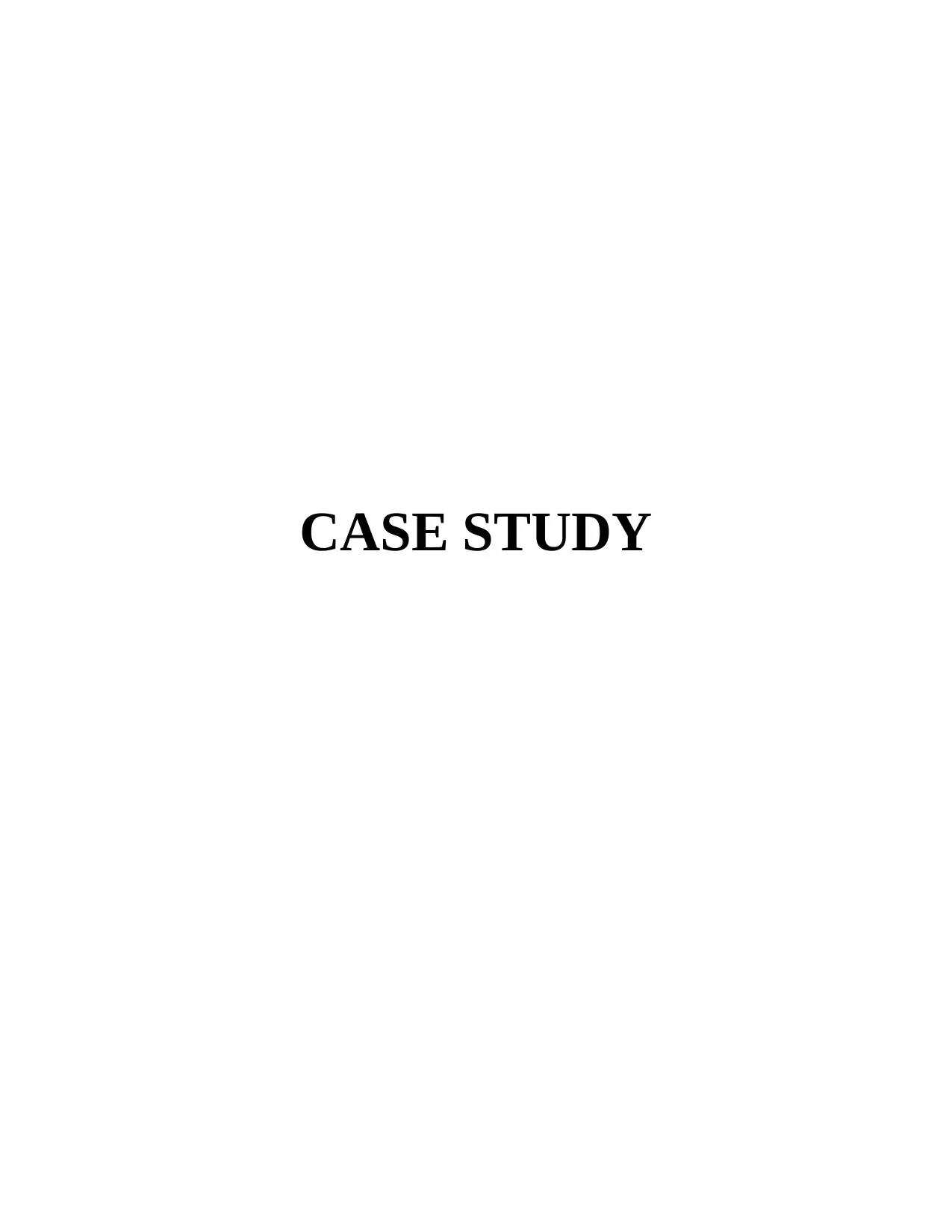
CASE STUDY
Paraphrase This Document
Need a fresh take? Get an instant paraphrase of this document with our AI Paraphraser
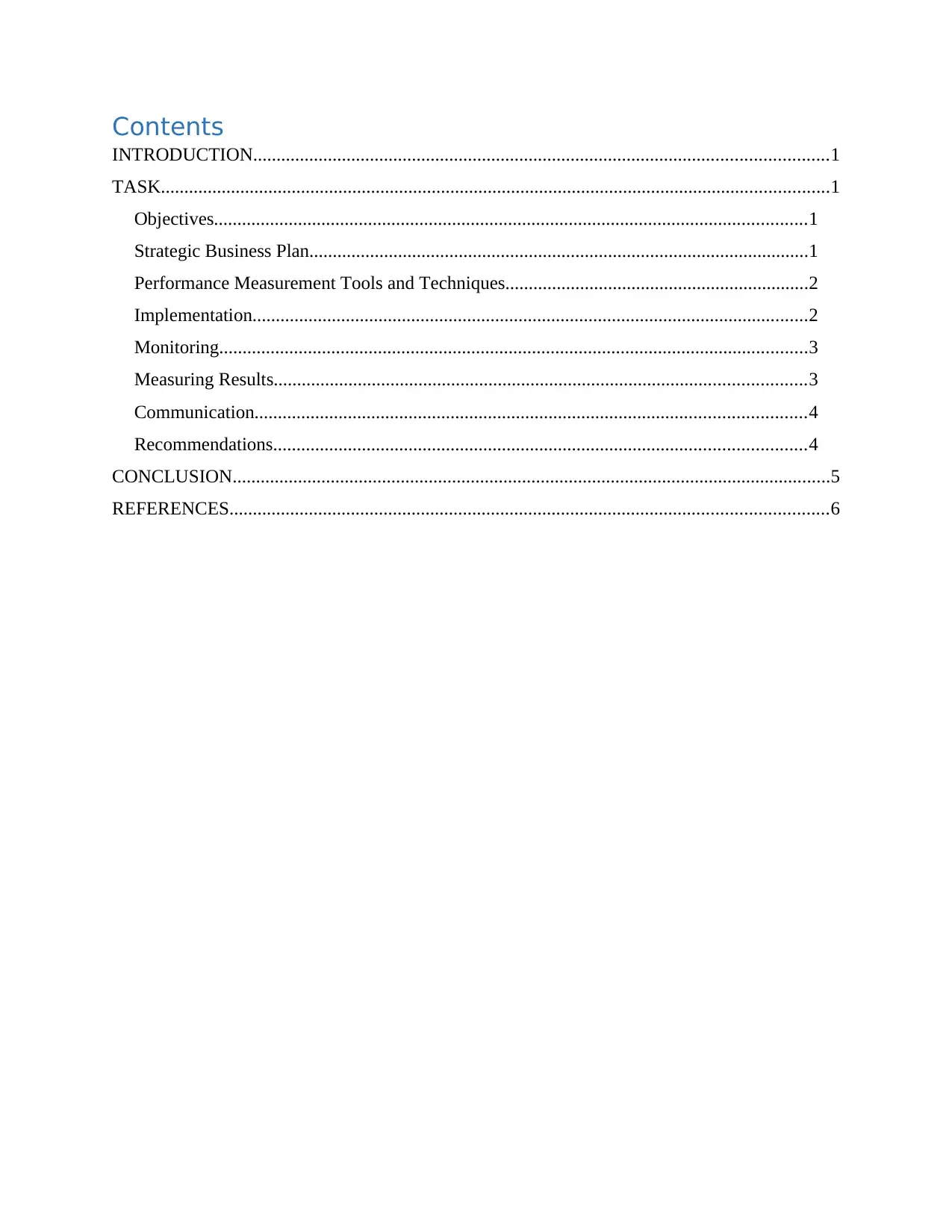
Contents
INTRODUCTION...........................................................................................................................1
TASK...............................................................................................................................................1
Objectives...............................................................................................................................1
Strategic Business Plan...........................................................................................................1
Performance Measurement Tools and Techniques.................................................................2
Implementation.......................................................................................................................2
Monitoring..............................................................................................................................3
Measuring Results..................................................................................................................3
Communication......................................................................................................................4
Recommendations..................................................................................................................4
CONCLUSION................................................................................................................................5
REFERENCES................................................................................................................................6
INTRODUCTION...........................................................................................................................1
TASK...............................................................................................................................................1
Objectives...............................................................................................................................1
Strategic Business Plan...........................................................................................................1
Performance Measurement Tools and Techniques.................................................................2
Implementation.......................................................................................................................2
Monitoring..............................................................................................................................3
Measuring Results..................................................................................................................3
Communication......................................................................................................................4
Recommendations..................................................................................................................4
CONCLUSION................................................................................................................................5
REFERENCES................................................................................................................................6

⊘ This is a preview!⊘
Do you want full access?
Subscribe today to unlock all pages.

Trusted by 1+ million students worldwide
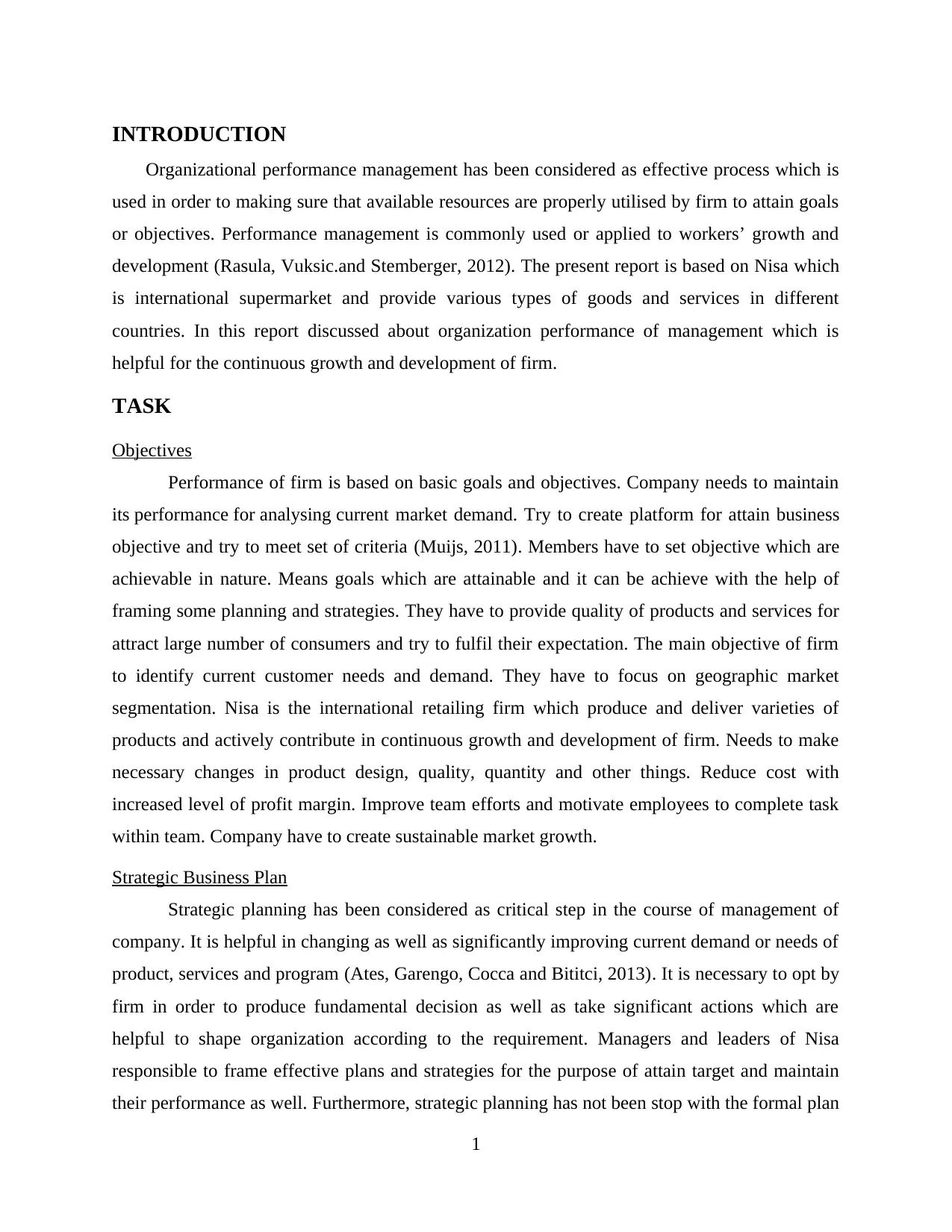
INTRODUCTION
Organizational performance management has been considered as effective process which is
used in order to making sure that available resources are properly utilised by firm to attain goals
or objectives. Performance management is commonly used or applied to workers’ growth and
development (Rasula, Vuksic.and Stemberger, 2012). The present report is based on Nisa which
is international supermarket and provide various types of goods and services in different
countries. In this report discussed about organization performance of management which is
helpful for the continuous growth and development of firm.
TASK
Objectives
Performance of firm is based on basic goals and objectives. Company needs to maintain
its performance for analysing current market demand. Try to create platform for attain business
objective and try to meet set of criteria (Muijs, 2011). Members have to set objective which are
achievable in nature. Means goals which are attainable and it can be achieve with the help of
framing some planning and strategies. They have to provide quality of products and services for
attract large number of consumers and try to fulfil their expectation. The main objective of firm
to identify current customer needs and demand. They have to focus on geographic market
segmentation. Nisa is the international retailing firm which produce and deliver varieties of
products and actively contribute in continuous growth and development of firm. Needs to make
necessary changes in product design, quality, quantity and other things. Reduce cost with
increased level of profit margin. Improve team efforts and motivate employees to complete task
within team. Company have to create sustainable market growth.
Strategic Business Plan
Strategic planning has been considered as critical step in the course of management of
company. It is helpful in changing as well as significantly improving current demand or needs of
product, services and program (Ates, Garengo, Cocca and Bititci, 2013). It is necessary to opt by
firm in order to produce fundamental decision as well as take significant actions which are
helpful to shape organization according to the requirement. Managers and leaders of Nisa
responsible to frame effective plans and strategies for the purpose of attain target and maintain
their performance as well. Furthermore, strategic planning has not been stop with the formal plan
1
Organizational performance management has been considered as effective process which is
used in order to making sure that available resources are properly utilised by firm to attain goals
or objectives. Performance management is commonly used or applied to workers’ growth and
development (Rasula, Vuksic.and Stemberger, 2012). The present report is based on Nisa which
is international supermarket and provide various types of goods and services in different
countries. In this report discussed about organization performance of management which is
helpful for the continuous growth and development of firm.
TASK
Objectives
Performance of firm is based on basic goals and objectives. Company needs to maintain
its performance for analysing current market demand. Try to create platform for attain business
objective and try to meet set of criteria (Muijs, 2011). Members have to set objective which are
achievable in nature. Means goals which are attainable and it can be achieve with the help of
framing some planning and strategies. They have to provide quality of products and services for
attract large number of consumers and try to fulfil their expectation. The main objective of firm
to identify current customer needs and demand. They have to focus on geographic market
segmentation. Nisa is the international retailing firm which produce and deliver varieties of
products and actively contribute in continuous growth and development of firm. Needs to make
necessary changes in product design, quality, quantity and other things. Reduce cost with
increased level of profit margin. Improve team efforts and motivate employees to complete task
within team. Company have to create sustainable market growth.
Strategic Business Plan
Strategic planning has been considered as critical step in the course of management of
company. It is helpful in changing as well as significantly improving current demand or needs of
product, services and program (Ates, Garengo, Cocca and Bititci, 2013). It is necessary to opt by
firm in order to produce fundamental decision as well as take significant actions which are
helpful to shape organization according to the requirement. Managers and leaders of Nisa
responsible to frame effective plans and strategies for the purpose of attain target and maintain
their performance as well. Furthermore, strategic planning has not been stop with the formal plan
1
Paraphrase This Document
Need a fresh take? Get an instant paraphrase of this document with our AI Paraphraser
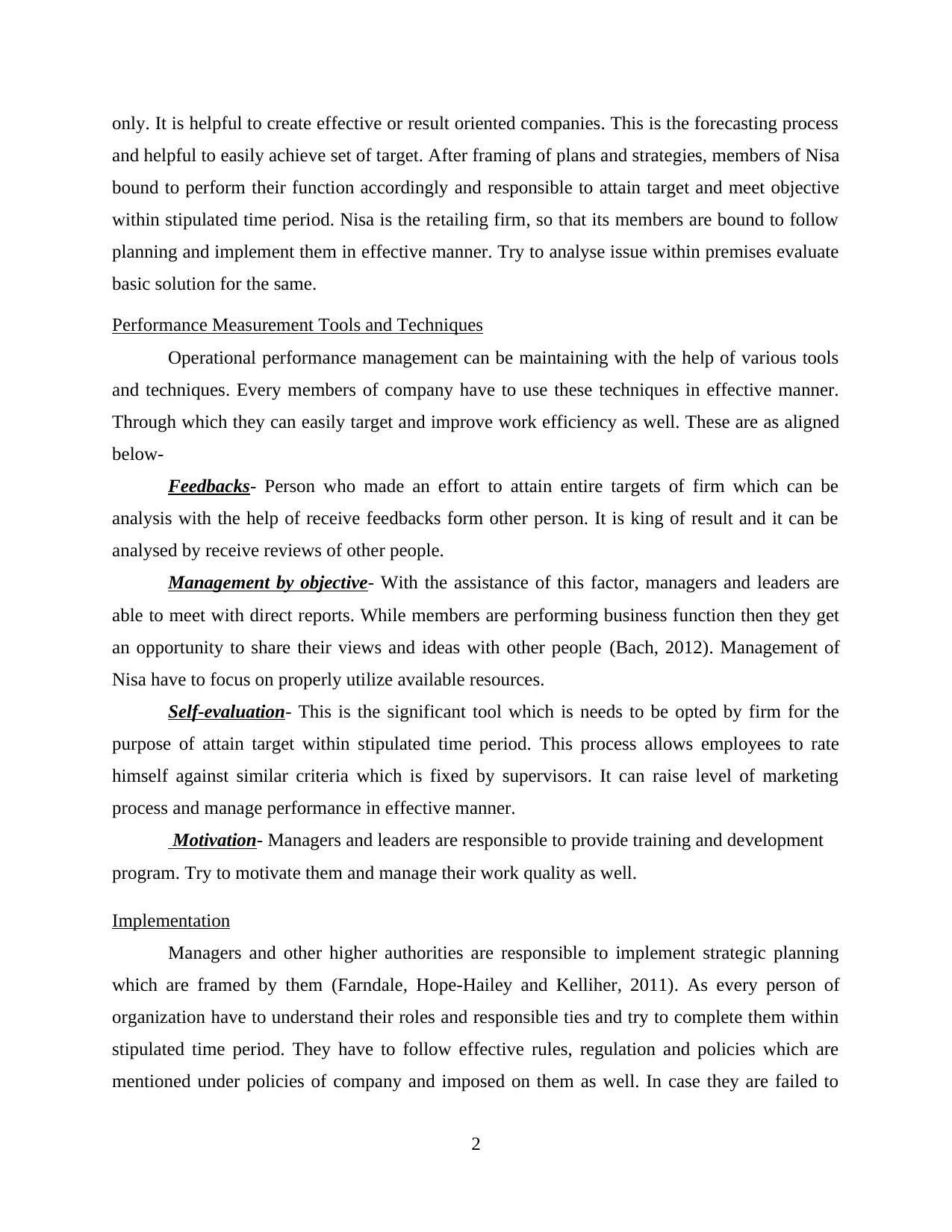
only. It is helpful to create effective or result oriented companies. This is the forecasting process
and helpful to easily achieve set of target. After framing of plans and strategies, members of Nisa
bound to perform their function accordingly and responsible to attain target and meet objective
within stipulated time period. Nisa is the retailing firm, so that its members are bound to follow
planning and implement them in effective manner. Try to analyse issue within premises evaluate
basic solution for the same.
Performance Measurement Tools and Techniques
Operational performance management can be maintaining with the help of various tools
and techniques. Every members of company have to use these techniques in effective manner.
Through which they can easily target and improve work efficiency as well. These are as aligned
below-
Feedbacks- Person who made an effort to attain entire targets of firm which can be
analysis with the help of receive feedbacks form other person. It is king of result and it can be
analysed by receive reviews of other people.
Management by objective- With the assistance of this factor, managers and leaders are
able to meet with direct reports. While members are performing business function then they get
an opportunity to share their views and ideas with other people (Bach, 2012). Management of
Nisa have to focus on properly utilize available resources.
Self-evaluation- This is the significant tool which is needs to be opted by firm for the
purpose of attain target within stipulated time period. This process allows employees to rate
himself against similar criteria which is fixed by supervisors. It can raise level of marketing
process and manage performance in effective manner.
Motivation- Managers and leaders are responsible to provide training and development
program. Try to motivate them and manage their work quality as well.
Implementation
Managers and other higher authorities are responsible to implement strategic planning
which are framed by them (Farndale, Hope-Hailey and Kelliher, 2011). As every person of
organization have to understand their roles and responsible ties and try to complete them within
stipulated time period. They have to follow effective rules, regulation and policies which are
mentioned under policies of company and imposed on them as well. In case they are failed to
2
and helpful to easily achieve set of target. After framing of plans and strategies, members of Nisa
bound to perform their function accordingly and responsible to attain target and meet objective
within stipulated time period. Nisa is the retailing firm, so that its members are bound to follow
planning and implement them in effective manner. Try to analyse issue within premises evaluate
basic solution for the same.
Performance Measurement Tools and Techniques
Operational performance management can be maintaining with the help of various tools
and techniques. Every members of company have to use these techniques in effective manner.
Through which they can easily target and improve work efficiency as well. These are as aligned
below-
Feedbacks- Person who made an effort to attain entire targets of firm which can be
analysis with the help of receive feedbacks form other person. It is king of result and it can be
analysed by receive reviews of other people.
Management by objective- With the assistance of this factor, managers and leaders are
able to meet with direct reports. While members are performing business function then they get
an opportunity to share their views and ideas with other people (Bach, 2012). Management of
Nisa have to focus on properly utilize available resources.
Self-evaluation- This is the significant tool which is needs to be opted by firm for the
purpose of attain target within stipulated time period. This process allows employees to rate
himself against similar criteria which is fixed by supervisors. It can raise level of marketing
process and manage performance in effective manner.
Motivation- Managers and leaders are responsible to provide training and development
program. Try to motivate them and manage their work quality as well.
Implementation
Managers and other higher authorities are responsible to implement strategic planning
which are framed by them (Farndale, Hope-Hailey and Kelliher, 2011). As every person of
organization have to understand their roles and responsible ties and try to complete them within
stipulated time period. They have to follow effective rules, regulation and policies which are
mentioned under policies of company and imposed on them as well. In case they are failed to
2
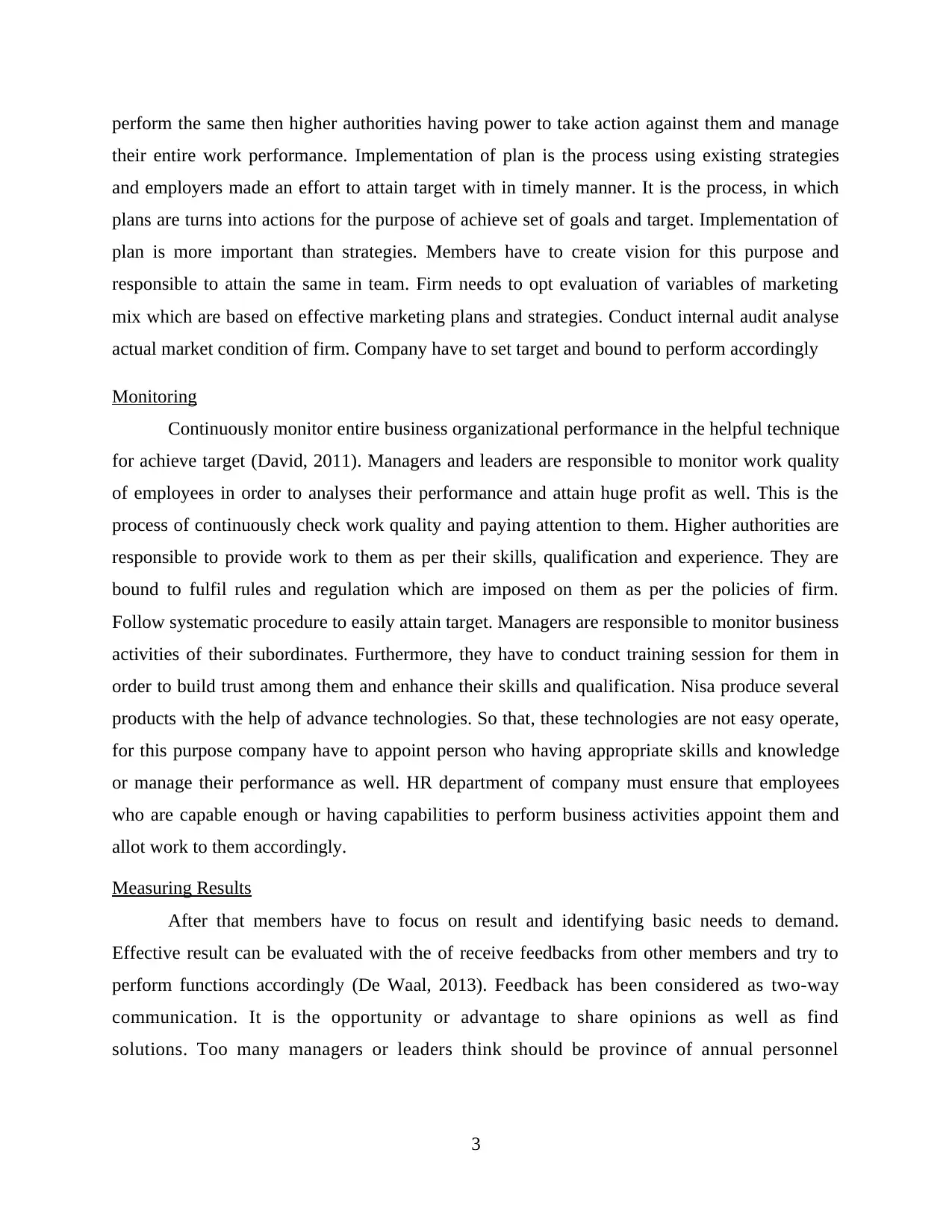
perform the same then higher authorities having power to take action against them and manage
their entire work performance. Implementation of plan is the process using existing strategies
and employers made an effort to attain target with in timely manner. It is the process, in which
plans are turns into actions for the purpose of achieve set of goals and target. Implementation of
plan is more important than strategies. Members have to create vision for this purpose and
responsible to attain the same in team. Firm needs to opt evaluation of variables of marketing
mix which are based on effective marketing plans and strategies. Conduct internal audit analyse
actual market condition of firm. Company have to set target and bound to perform accordingly
Monitoring
Continuously monitor entire business organizational performance in the helpful technique
for achieve target (David, 2011). Managers and leaders are responsible to monitor work quality
of employees in order to analyses their performance and attain huge profit as well. This is the
process of continuously check work quality and paying attention to them. Higher authorities are
responsible to provide work to them as per their skills, qualification and experience. They are
bound to fulfil rules and regulation which are imposed on them as per the policies of firm.
Follow systematic procedure to easily attain target. Managers are responsible to monitor business
activities of their subordinates. Furthermore, they have to conduct training session for them in
order to build trust among them and enhance their skills and qualification. Nisa produce several
products with the help of advance technologies. So that, these technologies are not easy operate,
for this purpose company have to appoint person who having appropriate skills and knowledge
or manage their performance as well. HR department of company must ensure that employees
who are capable enough or having capabilities to perform business activities appoint them and
allot work to them accordingly.
Measuring Results
After that members have to focus on result and identifying basic needs to demand.
Effective result can be evaluated with the of receive feedbacks from other members and try to
perform functions accordingly (De Waal, 2013). Feedback has been considered as two-way
communication. It is the opportunity or advantage to share opinions as well as find
solutions. Too many managers or leaders think should be province of annual personnel
3
their entire work performance. Implementation of plan is the process using existing strategies
and employers made an effort to attain target with in timely manner. It is the process, in which
plans are turns into actions for the purpose of achieve set of goals and target. Implementation of
plan is more important than strategies. Members have to create vision for this purpose and
responsible to attain the same in team. Firm needs to opt evaluation of variables of marketing
mix which are based on effective marketing plans and strategies. Conduct internal audit analyse
actual market condition of firm. Company have to set target and bound to perform accordingly
Monitoring
Continuously monitor entire business organizational performance in the helpful technique
for achieve target (David, 2011). Managers and leaders are responsible to monitor work quality
of employees in order to analyses their performance and attain huge profit as well. This is the
process of continuously check work quality and paying attention to them. Higher authorities are
responsible to provide work to them as per their skills, qualification and experience. They are
bound to fulfil rules and regulation which are imposed on them as per the policies of firm.
Follow systematic procedure to easily attain target. Managers are responsible to monitor business
activities of their subordinates. Furthermore, they have to conduct training session for them in
order to build trust among them and enhance their skills and qualification. Nisa produce several
products with the help of advance technologies. So that, these technologies are not easy operate,
for this purpose company have to appoint person who having appropriate skills and knowledge
or manage their performance as well. HR department of company must ensure that employees
who are capable enough or having capabilities to perform business activities appoint them and
allot work to them accordingly.
Measuring Results
After that members have to focus on result and identifying basic needs to demand.
Effective result can be evaluated with the of receive feedbacks from other members and try to
perform functions accordingly (De Waal, 2013). Feedback has been considered as two-way
communication. It is the opportunity or advantage to share opinions as well as find
solutions. Too many managers or leaders think should be province of annual personnel
3
⊘ This is a preview!⊘
Do you want full access?
Subscribe today to unlock all pages.

Trusted by 1+ million students worldwide
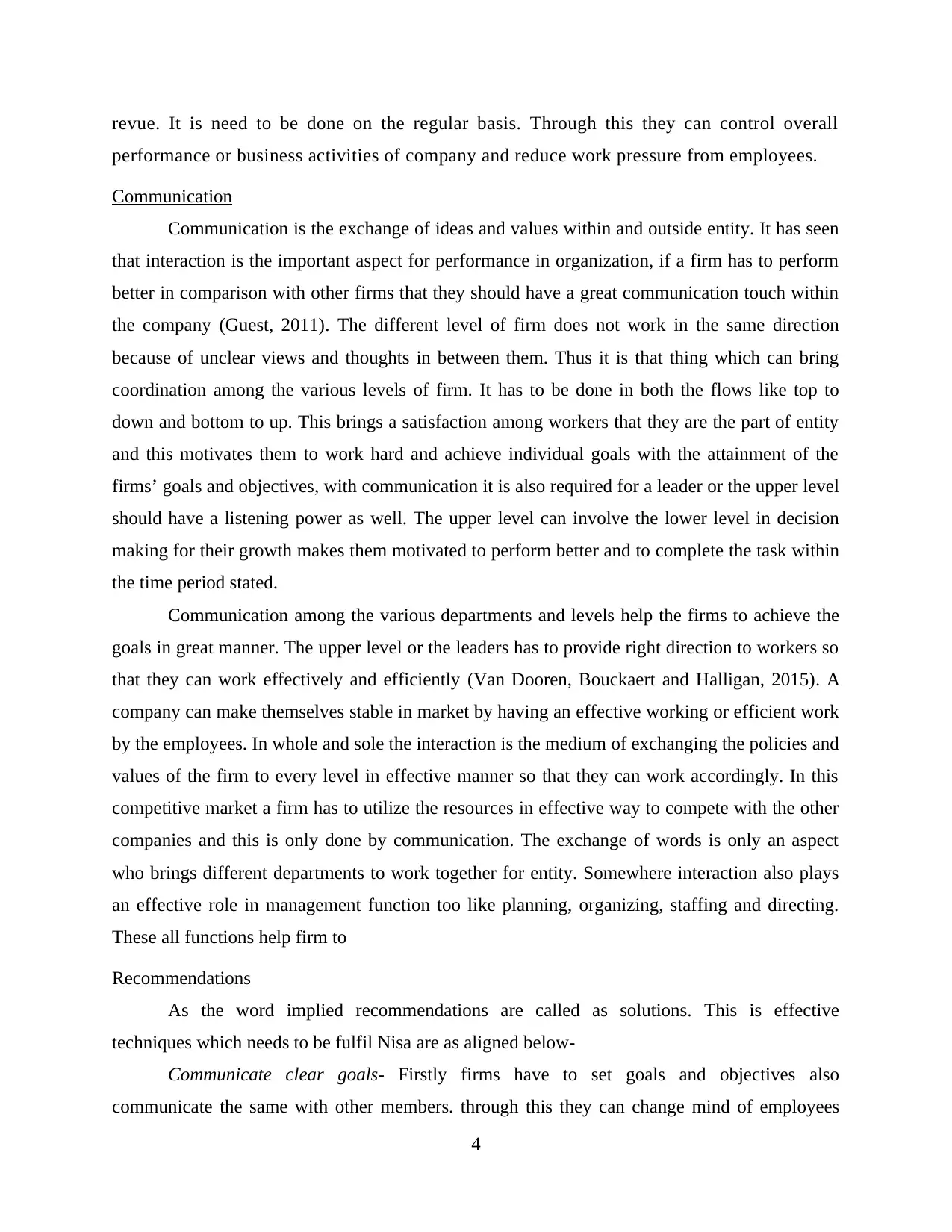
revue. It is need to be done on the regular basis. Through this they can control overall
performance or business activities of company and reduce work pressure from employees.
Communication
Communication is the exchange of ideas and values within and outside entity. It has seen
that interaction is the important aspect for performance in organization, if a firm has to perform
better in comparison with other firms that they should have a great communication touch within
the company (Guest, 2011). The different level of firm does not work in the same direction
because of unclear views and thoughts in between them. Thus it is that thing which can bring
coordination among the various levels of firm. It has to be done in both the flows like top to
down and bottom to up. This brings a satisfaction among workers that they are the part of entity
and this motivates them to work hard and achieve individual goals with the attainment of the
firms’ goals and objectives, with communication it is also required for a leader or the upper level
should have a listening power as well. The upper level can involve the lower level in decision
making for their growth makes them motivated to perform better and to complete the task within
the time period stated.
Communication among the various departments and levels help the firms to achieve the
goals in great manner. The upper level or the leaders has to provide right direction to workers so
that they can work effectively and efficiently (Van Dooren, Bouckaert and Halligan, 2015). A
company can make themselves stable in market by having an effective working or efficient work
by the employees. In whole and sole the interaction is the medium of exchanging the policies and
values of the firm to every level in effective manner so that they can work accordingly. In this
competitive market a firm has to utilize the resources in effective way to compete with the other
companies and this is only done by communication. The exchange of words is only an aspect
who brings different departments to work together for entity. Somewhere interaction also plays
an effective role in management function too like planning, organizing, staffing and directing.
These all functions help firm to
Recommendations
As the word implied recommendations are called as solutions. This is effective
techniques which needs to be fulfil Nisa are as aligned below-
Communicate clear goals- Firstly firms have to set goals and objectives also
communicate the same with other members. through this they can change mind of employees
4
performance or business activities of company and reduce work pressure from employees.
Communication
Communication is the exchange of ideas and values within and outside entity. It has seen
that interaction is the important aspect for performance in organization, if a firm has to perform
better in comparison with other firms that they should have a great communication touch within
the company (Guest, 2011). The different level of firm does not work in the same direction
because of unclear views and thoughts in between them. Thus it is that thing which can bring
coordination among the various levels of firm. It has to be done in both the flows like top to
down and bottom to up. This brings a satisfaction among workers that they are the part of entity
and this motivates them to work hard and achieve individual goals with the attainment of the
firms’ goals and objectives, with communication it is also required for a leader or the upper level
should have a listening power as well. The upper level can involve the lower level in decision
making for their growth makes them motivated to perform better and to complete the task within
the time period stated.
Communication among the various departments and levels help the firms to achieve the
goals in great manner. The upper level or the leaders has to provide right direction to workers so
that they can work effectively and efficiently (Van Dooren, Bouckaert and Halligan, 2015). A
company can make themselves stable in market by having an effective working or efficient work
by the employees. In whole and sole the interaction is the medium of exchanging the policies and
values of the firm to every level in effective manner so that they can work accordingly. In this
competitive market a firm has to utilize the resources in effective way to compete with the other
companies and this is only done by communication. The exchange of words is only an aspect
who brings different departments to work together for entity. Somewhere interaction also plays
an effective role in management function too like planning, organizing, staffing and directing.
These all functions help firm to
Recommendations
As the word implied recommendations are called as solutions. This is effective
techniques which needs to be fulfil Nisa are as aligned below-
Communicate clear goals- Firstly firms have to set goals and objectives also
communicate the same with other members. through this they can change mind of employees
4
Paraphrase This Document
Need a fresh take? Get an instant paraphrase of this document with our AI Paraphraser
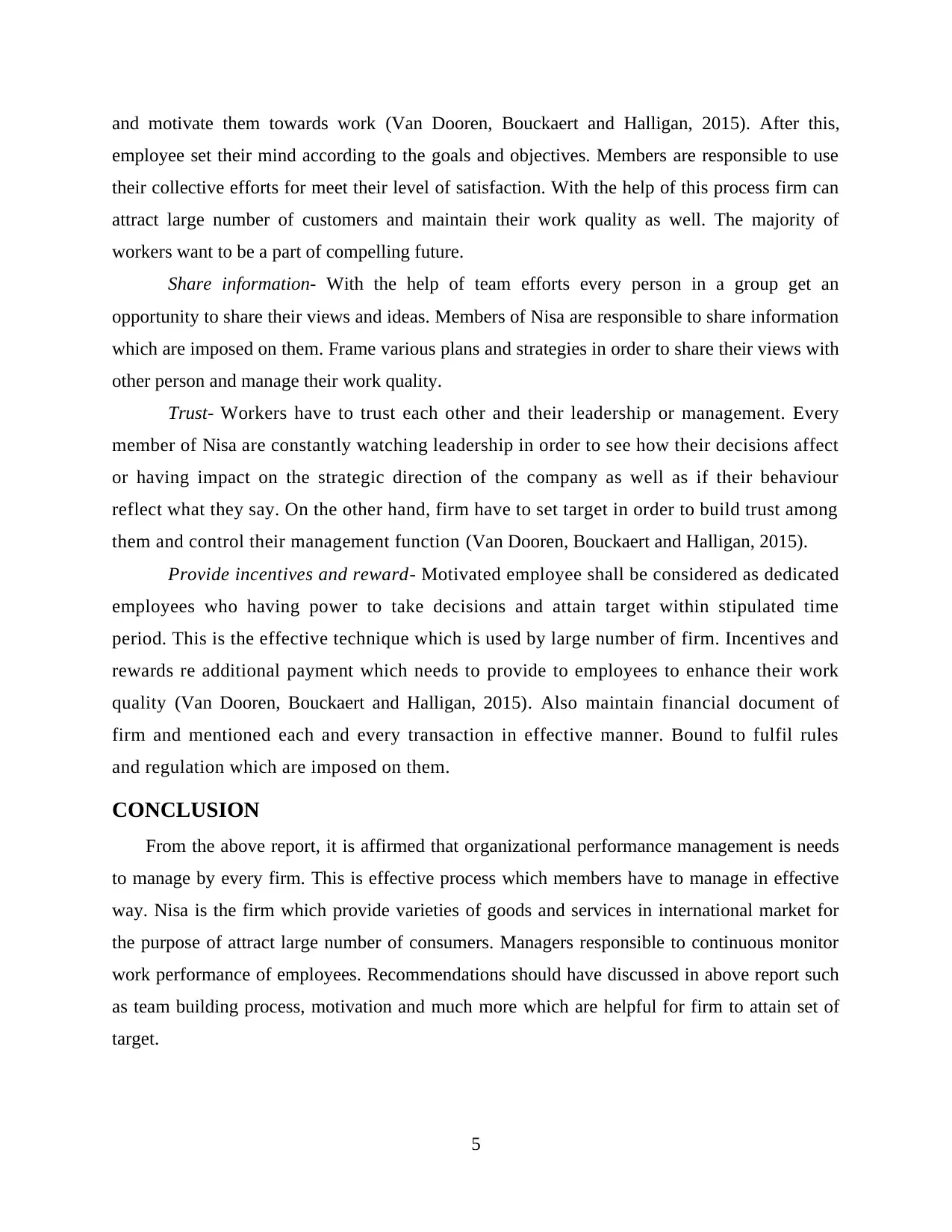
and motivate them towards work (Van Dooren, Bouckaert and Halligan, 2015). After this,
employee set their mind according to the goals and objectives. Members are responsible to use
their collective efforts for meet their level of satisfaction. With the help of this process firm can
attract large number of customers and maintain their work quality as well. The majority of
workers want to be a part of compelling future.
Share information- With the help of team efforts every person in a group get an
opportunity to share their views and ideas. Members of Nisa are responsible to share information
which are imposed on them. Frame various plans and strategies in order to share their views with
other person and manage their work quality.
Trust- Workers have to trust each other and their leadership or management. Every
member of Nisa are constantly watching leadership in order to see how their decisions affect
or having impact on the strategic direction of the company as well as if their behaviour
reflect what they say. On the other hand, firm have to set target in order to build trust among
them and control their management function (Van Dooren, Bouckaert and Halligan, 2015).
Provide incentives and reward- Motivated employee shall be considered as dedicated
employees who having power to take decisions and attain target within stipulated time
period. This is the effective technique which is used by large number of firm. Incentives and
rewards re additional payment which needs to provide to employees to enhance their work
quality (Van Dooren, Bouckaert and Halligan, 2015). Also maintain financial document of
firm and mentioned each and every transaction in effective manner. Bound to fulfil rules
and regulation which are imposed on them.
CONCLUSION
From the above report, it is affirmed that organizational performance management is needs
to manage by every firm. This is effective process which members have to manage in effective
way. Nisa is the firm which provide varieties of goods and services in international market for
the purpose of attract large number of consumers. Managers responsible to continuous monitor
work performance of employees. Recommendations should have discussed in above report such
as team building process, motivation and much more which are helpful for firm to attain set of
target.
5
employee set their mind according to the goals and objectives. Members are responsible to use
their collective efforts for meet their level of satisfaction. With the help of this process firm can
attract large number of customers and maintain their work quality as well. The majority of
workers want to be a part of compelling future.
Share information- With the help of team efforts every person in a group get an
opportunity to share their views and ideas. Members of Nisa are responsible to share information
which are imposed on them. Frame various plans and strategies in order to share their views with
other person and manage their work quality.
Trust- Workers have to trust each other and their leadership or management. Every
member of Nisa are constantly watching leadership in order to see how their decisions affect
or having impact on the strategic direction of the company as well as if their behaviour
reflect what they say. On the other hand, firm have to set target in order to build trust among
them and control their management function (Van Dooren, Bouckaert and Halligan, 2015).
Provide incentives and reward- Motivated employee shall be considered as dedicated
employees who having power to take decisions and attain target within stipulated time
period. This is the effective technique which is used by large number of firm. Incentives and
rewards re additional payment which needs to provide to employees to enhance their work
quality (Van Dooren, Bouckaert and Halligan, 2015). Also maintain financial document of
firm and mentioned each and every transaction in effective manner. Bound to fulfil rules
and regulation which are imposed on them.
CONCLUSION
From the above report, it is affirmed that organizational performance management is needs
to manage by every firm. This is effective process which members have to manage in effective
way. Nisa is the firm which provide varieties of goods and services in international market for
the purpose of attract large number of consumers. Managers responsible to continuous monitor
work performance of employees. Recommendations should have discussed in above report such
as team building process, motivation and much more which are helpful for firm to attain set of
target.
5
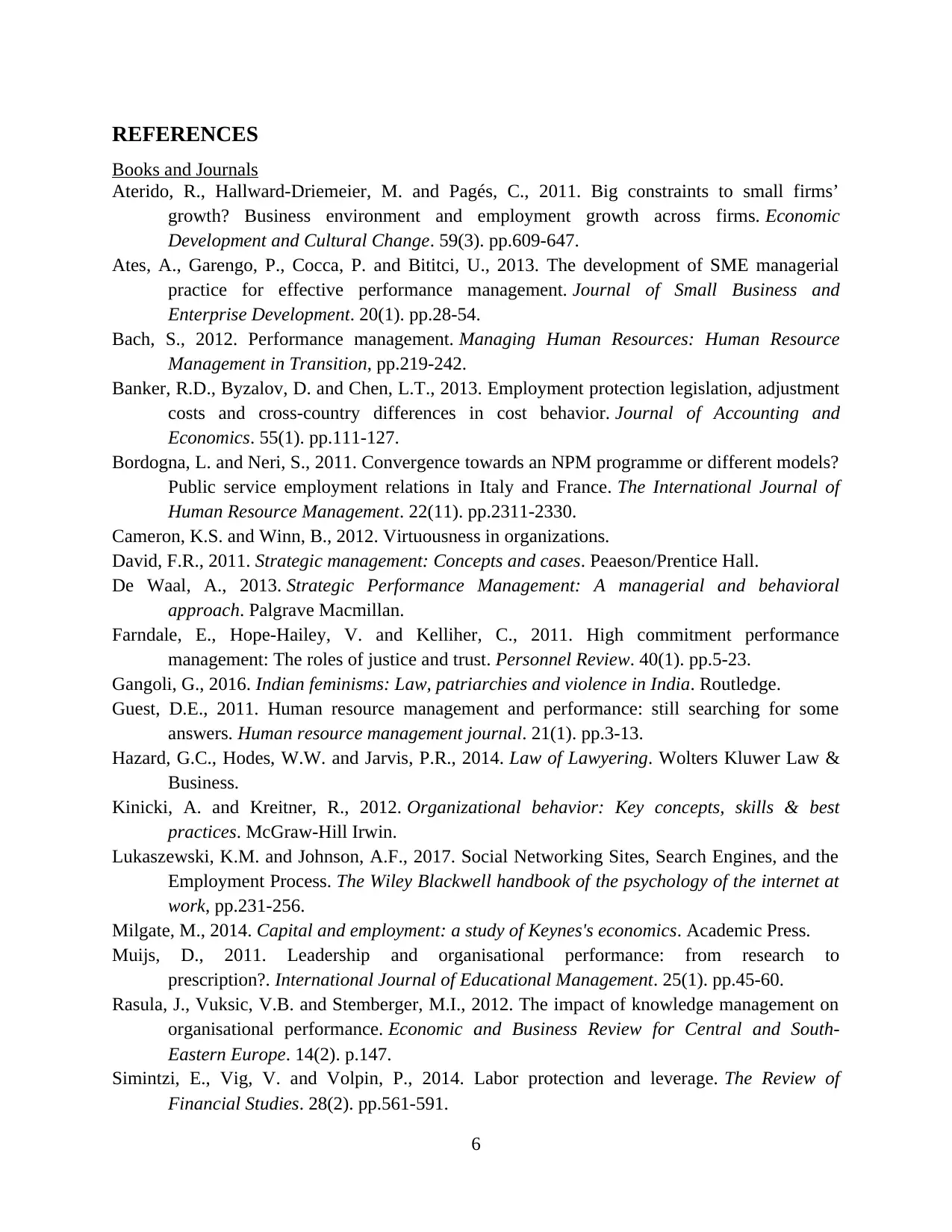
REFERENCES
Books and Journals
Aterido, R., Hallward-Driemeier, M. and Pagés, C., 2011. Big constraints to small firms’
growth? Business environment and employment growth across firms. Economic
Development and Cultural Change. 59(3). pp.609-647.
Ates, A., Garengo, P., Cocca, P. and Bititci, U., 2013. The development of SME managerial
practice for effective performance management. Journal of Small Business and
Enterprise Development. 20(1). pp.28-54.
Bach, S., 2012. Performance management. Managing Human Resources: Human Resource
Management in Transition, pp.219-242.
Banker, R.D., Byzalov, D. and Chen, L.T., 2013. Employment protection legislation, adjustment
costs and cross-country differences in cost behavior. Journal of Accounting and
Economics. 55(1). pp.111-127.
Bordogna, L. and Neri, S., 2011. Convergence towards an NPM programme or different models?
Public service employment relations in Italy and France. The International Journal of
Human Resource Management. 22(11). pp.2311-2330.
Cameron, K.S. and Winn, B., 2012. Virtuousness in organizations.
David, F.R., 2011. Strategic management: Concepts and cases. Peaeson/Prentice Hall.
De Waal, A., 2013. Strategic Performance Management: A managerial and behavioral
approach. Palgrave Macmillan.
Farndale, E., Hope-Hailey, V. and Kelliher, C., 2011. High commitment performance
management: The roles of justice and trust. Personnel Review. 40(1). pp.5-23.
Gangoli, G., 2016. Indian feminisms: Law, patriarchies and violence in India. Routledge.
Guest, D.E., 2011. Human resource management and performance: still searching for some
answers. Human resource management journal. 21(1). pp.3-13.
Hazard, G.C., Hodes, W.W. and Jarvis, P.R., 2014. Law of Lawyering. Wolters Kluwer Law &
Business.
Kinicki, A. and Kreitner, R., 2012. Organizational behavior: Key concepts, skills & best
practices. McGraw-Hill Irwin.
Lukaszewski, K.M. and Johnson, A.F., 2017. Social Networking Sites, Search Engines, and the
Employment Process. The Wiley Blackwell handbook of the psychology of the internet at
work, pp.231-256.
Milgate, M., 2014. Capital and employment: a study of Keynes's economics. Academic Press.
Muijs, D., 2011. Leadership and organisational performance: from research to
prescription?. International Journal of Educational Management. 25(1). pp.45-60.
Rasula, J., Vuksic, V.B. and Stemberger, M.I., 2012. The impact of knowledge management on
organisational performance. Economic and Business Review for Central and South-
Eastern Europe. 14(2). p.147.
Simintzi, E., Vig, V. and Volpin, P., 2014. Labor protection and leverage. The Review of
Financial Studies. 28(2). pp.561-591.
6
Books and Journals
Aterido, R., Hallward-Driemeier, M. and Pagés, C., 2011. Big constraints to small firms’
growth? Business environment and employment growth across firms. Economic
Development and Cultural Change. 59(3). pp.609-647.
Ates, A., Garengo, P., Cocca, P. and Bititci, U., 2013. The development of SME managerial
practice for effective performance management. Journal of Small Business and
Enterprise Development. 20(1). pp.28-54.
Bach, S., 2012. Performance management. Managing Human Resources: Human Resource
Management in Transition, pp.219-242.
Banker, R.D., Byzalov, D. and Chen, L.T., 2013. Employment protection legislation, adjustment
costs and cross-country differences in cost behavior. Journal of Accounting and
Economics. 55(1). pp.111-127.
Bordogna, L. and Neri, S., 2011. Convergence towards an NPM programme or different models?
Public service employment relations in Italy and France. The International Journal of
Human Resource Management. 22(11). pp.2311-2330.
Cameron, K.S. and Winn, B., 2012. Virtuousness in organizations.
David, F.R., 2011. Strategic management: Concepts and cases. Peaeson/Prentice Hall.
De Waal, A., 2013. Strategic Performance Management: A managerial and behavioral
approach. Palgrave Macmillan.
Farndale, E., Hope-Hailey, V. and Kelliher, C., 2011. High commitment performance
management: The roles of justice and trust. Personnel Review. 40(1). pp.5-23.
Gangoli, G., 2016. Indian feminisms: Law, patriarchies and violence in India. Routledge.
Guest, D.E., 2011. Human resource management and performance: still searching for some
answers. Human resource management journal. 21(1). pp.3-13.
Hazard, G.C., Hodes, W.W. and Jarvis, P.R., 2014. Law of Lawyering. Wolters Kluwer Law &
Business.
Kinicki, A. and Kreitner, R., 2012. Organizational behavior: Key concepts, skills & best
practices. McGraw-Hill Irwin.
Lukaszewski, K.M. and Johnson, A.F., 2017. Social Networking Sites, Search Engines, and the
Employment Process. The Wiley Blackwell handbook of the psychology of the internet at
work, pp.231-256.
Milgate, M., 2014. Capital and employment: a study of Keynes's economics. Academic Press.
Muijs, D., 2011. Leadership and organisational performance: from research to
prescription?. International Journal of Educational Management. 25(1). pp.45-60.
Rasula, J., Vuksic, V.B. and Stemberger, M.I., 2012. The impact of knowledge management on
organisational performance. Economic and Business Review for Central and South-
Eastern Europe. 14(2). p.147.
Simintzi, E., Vig, V. and Volpin, P., 2014. Labor protection and leverage. The Review of
Financial Studies. 28(2). pp.561-591.
6
⊘ This is a preview!⊘
Do you want full access?
Subscribe today to unlock all pages.

Trusted by 1+ million students worldwide
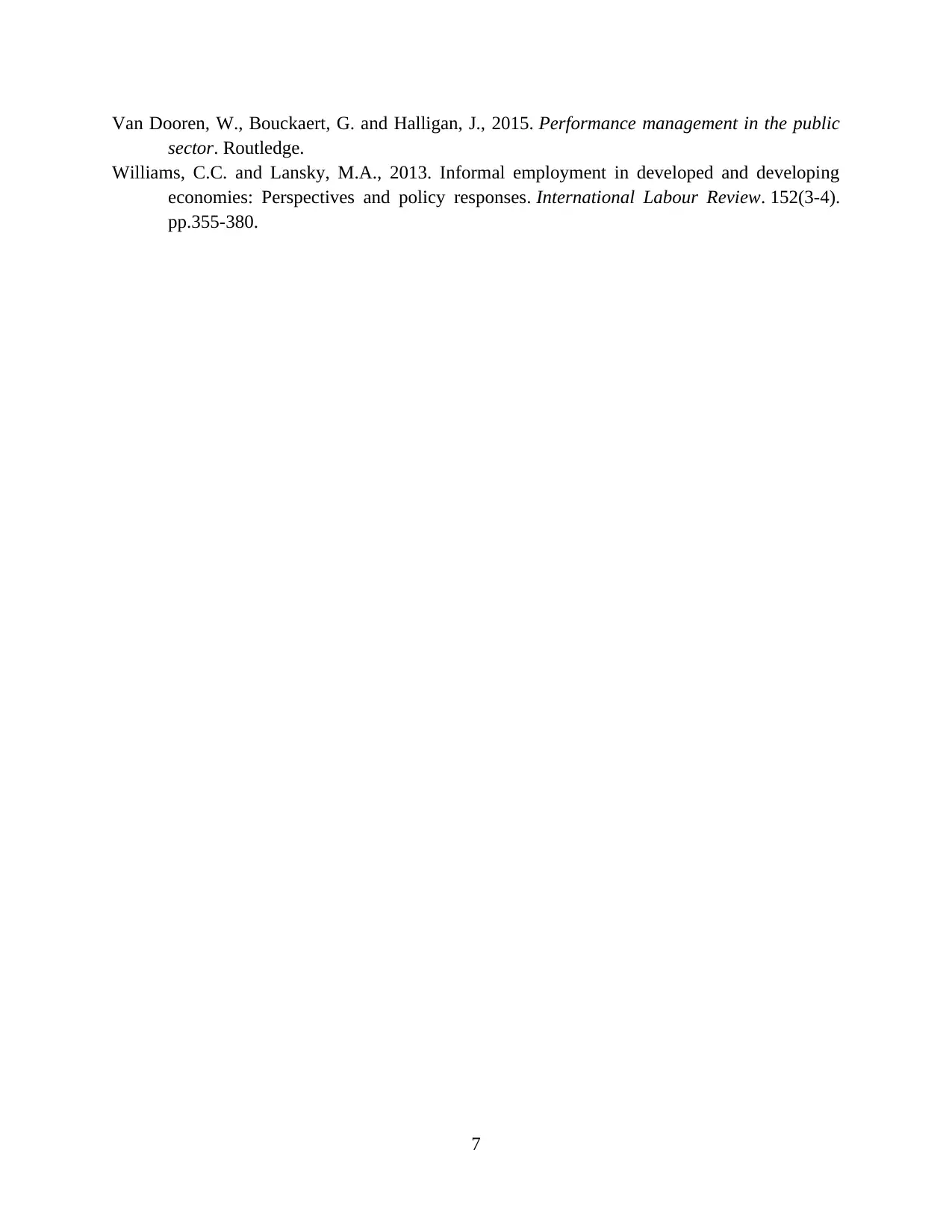
Van Dooren, W., Bouckaert, G. and Halligan, J., 2015. Performance management in the public
sector. Routledge.
Williams, C.C. and Lansky, M.A., 2013. Informal employment in developed and developing
economies: Perspectives and policy responses. International Labour Review. 152(3-4).
pp.355-380.
7
sector. Routledge.
Williams, C.C. and Lansky, M.A., 2013. Informal employment in developed and developing
economies: Perspectives and policy responses. International Labour Review. 152(3-4).
pp.355-380.
7
1 out of 10
Related Documents
Your All-in-One AI-Powered Toolkit for Academic Success.
+13062052269
info@desklib.com
Available 24*7 on WhatsApp / Email
![[object Object]](/_next/static/media/star-bottom.7253800d.svg)
Unlock your academic potential
Copyright © 2020–2025 A2Z Services. All Rights Reserved. Developed and managed by ZUCOL.





